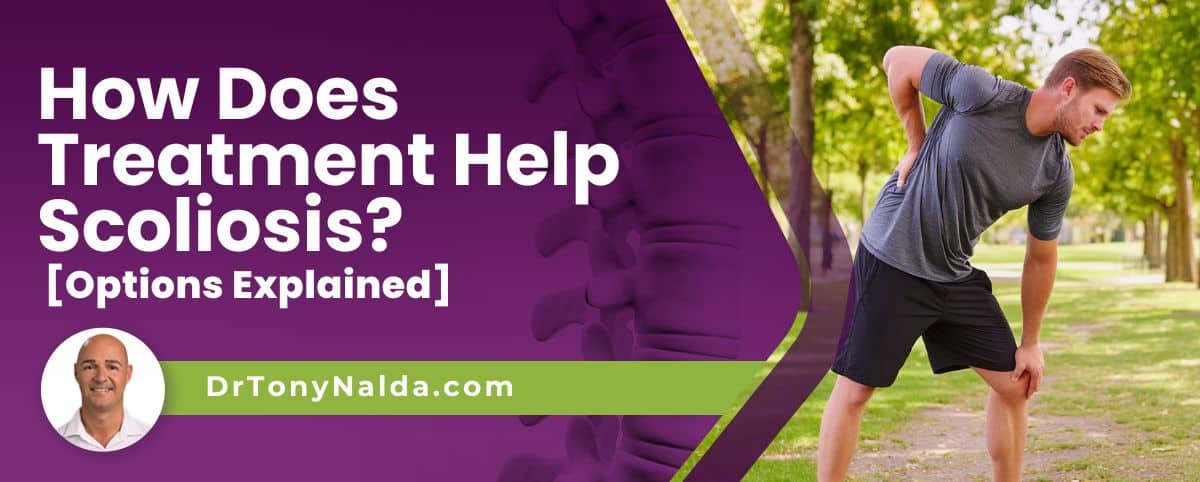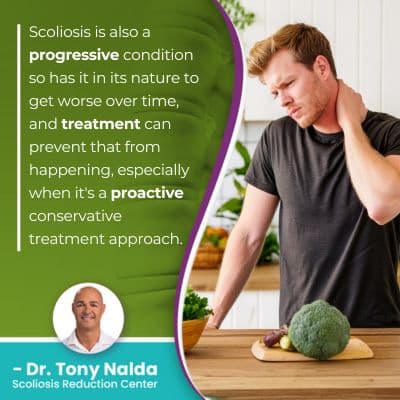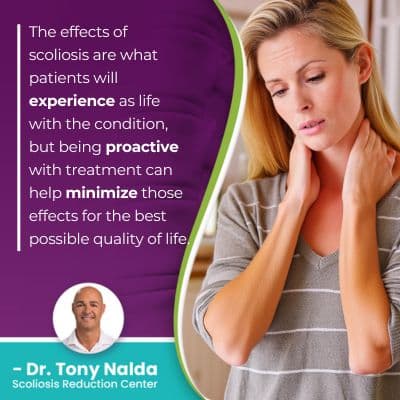How Does Treatment Help Scoliosis? [Options Explained]

The way a diagnosis is responded to with treatment is crucial. Choosing to address scoliosis, when to address it, and how will shape the spine's long-term health and function, which can shape a person's overall quality of life.
Scoliosis treatment is the best way to minimize the condition's effects. Scoliosis is a progressive condition so has it in its nature to get worse over time, and that means the condition's uneven forces are going to increase over time, as are their effects.
As scoliosis treatment starts with diagnosing and classifying conditions, let's start there.
Table of Contents
Diagnosing and Classifying Scoliosis
Diagnosing scoliosis isn't always a simple process; it can be subtle and difficult to detect.
Scoliosis patients can experience subtle or overt symptoms that are shaped by a variety of variables.
Being diagnosed with scoliosis means an unnatural sideways spinal curve has developed; when the spine loses one or more of its healthy curves, they are replaced by bad curves.
Diagnosing scoliosis involves a physical examination and X-ray results, and conditions are then further classified around key patient/condition variables such as patient age, condition type, severity, and curvature location.
Even within those classification points, there are more specifications such as curvature type and pattern.
The spine allows us to stand upright, practice good posture, protects important organs, and works in tandem with the brain to form the central nervous system, so conditions that cause the spine to bend unnaturally and twist, as scoliosis does, can have a number of effects.
 Scoliosis is also a progressive condition so has it in its nature to get worse over time, and treatment can prevent that from happening, especially when it's a proactive conservative treatment approach.
Scoliosis is also a progressive condition so has it in its nature to get worse over time, and treatment can prevent that from happening, especially when it's a proactive conservative treatment approach.
There are different ways to treat scoliosis that shape long-term spinal health and function, and it's important to understand the difference so an informed treatment decision can be made.
There was a time when traditional scoliosis treatment was the dominant choice, but that doesn't mean it was the only or best choice; the proven results of conservative treatment support that.
As scoliosis progression is triggered by growth, childhood scoliosis should always be taken seriously as its nature is to get worse as a child grows; if diagnosed and treated prior to entering into adolescence and puberty, scoliosis can be highly responsive.
Scoliosis Treatment Options
The two treatment approaches are traditional and conservative treatment; traditional offers a surgical response for severe curves, while conservative treatment is proactive so is started as close to the time of diagnosis as possible.
Traditional treatment doesn't have a strategy for addressing scoliosis while mild so does little to prevent it from becoming severe, other than apply traditional bracing, which is associated with a number of shortfalls.
Conservative treatment for scoliosis involves integrating multiple different types of treatment so scoliosis can be impacted on every level with the goal of preventing progression.
So conservative treatment has the benefit of sparing patients the hardships of increasing condition severity, and as scoliosis progresses, its effects become more noticeable.
The effects of scoliosis are what patients will experience as life with the condition, but being proactive with treatment can help minimize those effects for the best possible quality of life.
How Does Surgical Treatment Work?
Traditional treatment offers a reactive response because it does little towards prevention; the goal of traditional treatment is not to correct the scoliosis, but to stop it from getting worse: an important distinction.
Scoliosis ranges in severity from mild scoliosis to moderate scoliosis and severe to very severe scoliosis, and at the mild level, it's going to be the simplest to treat, so if diagnosed at the mild level, the decision is whether to watch and wait, or start treatment.
Traditional treatment commonly recommends watching and waiting to see if a condition progresses, but as scoliosis is virtually guaranteed to do so, this is wasting valuable treatment time while the condition is at its mildest.
As scoliosis progresses, the spine gets increasingly rigid, and this makes it less responsive to treatment.
In many cases, at the moderate level, bracing is applied, and the most commonly-used traditional brace is the boston brace, but the brace is limited for a number of reasons:
- It only addresses scoliosis as a 2-dimensional condition
- It squeezes the spine, weakening it over time
- The brace isn't fully customized so is uncomfortable to wear
- Compliance issues are common
If a traditional brace fails to stop scoliosis from getting worse, spinal fusion surgery is commonly recommended.
Spinal fusion surgery is lengthy, costly, and invasive, and while this type of scoliosis treatment can straighten a bent spine, the way it does so is contrary to the spine's movement-based design so can cost it in terms of its strength and function.
The process involves fusing the curve's most-tilted vertebrae into one solid bone and commonly involves attaching rods to the spine with screws to hold the spine in a straighter position.
This can, however, eliminate movement in the portion that's fused, so depending on how many vertebral bodies are fused, a noticeable loss in spinal flexibility and range of motion can be disruptive for many, and the procedure itself is associated with a number of risks.
So how can nonsurgical scoliosis treatment help?
The Benefits of Nonsurgical Scoliosis Treatment
 The success of nonsurgical scoliosis treatment proves that not all cases of scoliosis need surgery, especially with early detection and treatment.
The success of nonsurgical scoliosis treatment proves that not all cases of scoliosis need surgery, especially with early detection and treatment.
There are never treatment guarantees, but especially when diagnosed while mild, there are fewer limits to what can be achieved, but only if that diagnosis is responded to with proactive conservative treatment.
Nonsurgical treatment is chiropractic-centered and functional; it works towards preserving as much of the spine's healthy curves as possible, so it actually improves the spine's flexibility and range of motion, and this is worked towards through the integration of multiple scoliosis-specific treatment disciplines.
As a structural spinal condition, scoliosis has to primarily be impacted on a structural level, and scoliosis-specific chiropractic treatment works towards this through a number of techniques and manual adjustments that are applied to realign the spine.
Realigning the spine means its vertebrae are stacked on top of one another in a straight and neutral alignment and its healthy curves are in place.
Once my chiropractic adjustments start to reposition the curve's most-tilted vertebrae, it's time to start strengthening the spine's surrounding muscles, and increasing core strength has a number of benefits:
- Better support for the spine
- Better spinal stabilization
- Improving posture
Combining scoliosis-specific physical therapy with scoliosis-specific exercises (SSEs) is also known to activate specific areas of the brain for improved brain-body communication and positioning.
Corrective bracing can also help with achieving corrective treatment results and is particularly effective on growing spines so is a regular facet of treatment for adolescent idiopathic scoliosis, the condition's most-prevalent type.
Rehabilitation is the ongoing phase of treatment that involves continued chiropractic treatment and the prescription of a series of scoliosis-specific exercises designed to further heal and stabilize the spine from home.
Conclusion
Scoliosis treatment helps scoliosis by managing an ongoing condition, and when it's proactive, it can help prevent scoliosis patients from progressing and experiencing increasing condition effects.
Treating scoliosis proactively means starting as close to the time of diagnosis as possible; this is when conditions are going to be at their mildest and most responsive to treatment.
Not only does progression cause increasing spinal rigidity, making it less responsive to treatment, it also makes it difficult for some patients to perform certain therapeutic exercises important for treatment.
Treatment helps scoliosis by addressing the condition's structural nature, realigning the spine, increasing core strength, and rehabilitating it for long-term sustainable treatment results.
Treatment is the only way to counteract the condition's progressive nature, and once scoliosis becomes severe, for those on the path of traditional scoliosis treatment, this is when surgery is commonly recommended, and spinal fusion surgery can make the spine weaker and less functional.
Conservative treatment for scoliosis is also known as functional treatment because its approach is aligned with preserving as much as possible of the spine's natural strength and function.
Conservative treatment is non-invasive, while spinal fusion carries risks, and once a spine is fused, it's fused for life; should the surgery fail in some capacity, the only recourse is more surgery, and the risks increase with age and each subsequent procedure.
Here at the Scoliosis Reduction Center, I believe in the power of proactive treatment; when successful, it can spare patients the hardships of progression, increasing condition effects, and the need for invasive surgical treatment in the future.
Dr. Tony Nalda
DOCTOR OF CHIROPRACTIC
After receiving an undergraduate degree in psychology and his Doctorate of Chiropractic from Life University, Dr. Nalda settled in Celebration, Florida and proceeded to build one of Central Florida’s most successful chiropractic clinics.
His experience with patients suffering from scoliosis, and the confusion and frustration they faced, led him to seek a specialty in scoliosis care. In 2006 he completed his Intensive Care Certification from CLEAR Institute, a leading scoliosis educational and certification center.
About Dr. Tony Nalda
 Ready to explore scoliosis treatment? Contact Us Now
Ready to explore scoliosis treatment? Contact Us Now





